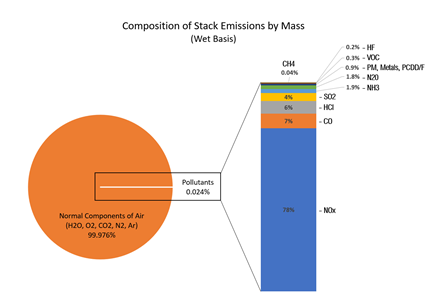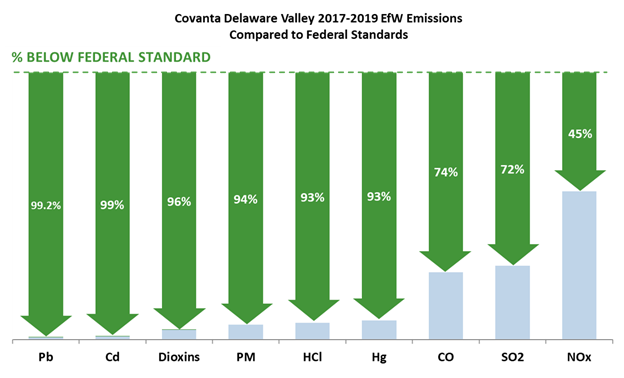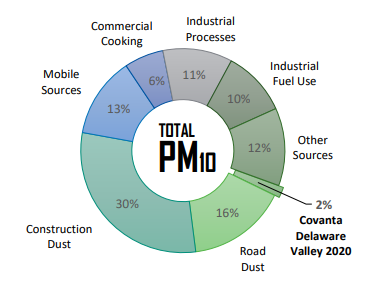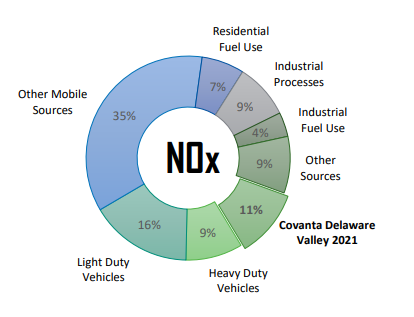Why was the facility built?
The Delaware Valley Resource Recovery Facility, located in Chester, PA was opened in 1992. Then under operation by a different organization, the facility was created to fulfill the waste management needs of Delaware County and the surrounding region. Today, under operation by Covanta after acquiring it in 2005, the facility sustainably processes more than 1.2 million tons of waste on an annual basis. It is among the largest facilities in our fleet, but there are very similar sized facilities in operation all around the country. We operate two facilities in West Palm Beach, FL that are adjacent to one another and process approximately 5,000 tons of waste per day, which is considerably more waste than the Chester facility. We also operate similar sized facilities in Fairfax County, VA, Long Island, NY, Honolulu, HI and just off Cape Cod in Rochester, MA. To learn more about operations at Covanta Delaware Valley, check out the facility fact sheet here.
What happens to the waste processed at the facility?
Waste delivered to Covanta Delaware Valley is combusted to both minimize the volume of waste, and create steam to generate electricity through a process called ‘Waste-to-Energy’ (WTE). The facility generates enough electricity to power roughly 54,000 homes annually and recycles enough metal to build nearly 49,000 cars. To learn more about WTE, go here.
Where does waste processed at the facility come from?
The facility primarily serves the solid waste disposal needs of Delaware County, including the City of Chester. The remaining processing capacity of the facility is used to provide a sustainable waste management alternative to landfills, for communities in Pennsylvania, New York, New Jersey, and parts of Maryland.
What is emitted from the stack?
Over 99.9% of what is emitted from the stack consists of normal components of air, including nitrogen, oxygen, and water vapor. Approximately 12.5% of that is carbon dioxide (CO2), 10% oxygen, and 68% nitrogen.

The remaining 0.024% of what is emitted from the stack includes nitrogen oxides (NOx), sulfur dioxide (SO2), carbon monoxide (CO), particulate matter (PM), and volatile organic compounds (VOCs) among several other substances considered pollutants. For these and other constituents, Covanta Delaware Valley performs well below federal and regional standards. To learn more about our environmental performance, as well as emissions from other sources within Delaware County, check out the full Facility Fact Sheet here.
How do we know that the facility runs the same all year long?
A combination of continuous emissions monitoring and annual stack testing are important tools used to determine the facility’s compliance with the emission limits set forth in its operating permit, which is established in accordance with the Clean Air Act and state regulatory requirements.
The facility’s operating permit sets the limits on:
- the amount of waste processed,
- the emissions that are allowed, and
- how the air pollution control system is operated.
The stack test sets additional limits on how we operate. Certain operating parameters, like waste throughput and air pollution control operation, become requirements until our next stack test.
In addition, there are monitors that operate continuously, 24 hours a day 7 days a week for 365 days a year to check that the combustion units are operating well, and the air pollution control systems are functioning properly.
The continuous emissions monitoring equipment at the Delaware Valley Waste-to-Energy incinerator monitors for opacity (a measure of particulate matter) and gaseous compounds such as nitrogen oxides and sulfur dioxides. The facility’s operators also continuously measure the amount of steam produced, as well as ensure the consistent high temperature (approximately 2,000 degrees Fahrenheit) required for full combustion is achieved by monitoring and maintaining proper oxygen and carbon monoxide levels.
The key to low emissions is good combustion. If carbon monoxide goes up, oxygen levels drop, temperature drops, or steam levels drop - the control room operator knows to adjust fuel rates or the air being fed to the combustion. If the monitor shows alerts for sulfur compounds, nitrogen compounds, or opacity, the facility staff checks and adjusts the air pollution control systems.
On rare occasions the facility may have a period of noncompliance related to carbon monoxide (CO). This is usually due to do a disruption in the combustion process, sometimes due to wet waste, and is corrected very quickly. Importantly, this serves as a warning signal for operators to make adjustments to ensure robust combustion.
Monitoring data is shared with the Pennsylvania Department of Environmental Protection (DEP) and the facility’s air permit stipulates compliance periods of 6 minutes, 1 hour, 3 hours, 4 hours and daily averages. Every year there are hundreds of thousands of compliance periods the facility must comply with. If levels go beyond certain limits for a specified duration, they must be reported to the DEP. We encourage anyone interested in the environmental performance of Covanta Delaware Valley to check out live continuous emissions monitoring systems (CEMS) data, now available through the facility webpage.
Does the Delaware Valley facility have fewer pollution controls than other WTE facilities?
The Covanta Chester facility uses rotary combustion technology and cannot be directly compared to other mass burn grate technology facilities, which are more common. Despite the differences in the number of emission control systems, the technology employed at the Chester facility outperforms and produces lower emissions of nitrogen oxides, for example, than mass burn grate facilities with nitrogen oxide control systems. The main differences between the Chester facility and other Waste-to-Energy incinerators operated around the country, including Covanta’s, are technological and ultimately have little to no bearing on overall environmental performance.

Despite already operating well below emissions standards, we are always working to minimize environmental impacts and are not opposed to implementing more pollution controls as new technology develops. In fact, in our recent sustainability report, we committed to installing more emissions control technology at our facilities located in environmental justice communities. We are currently evaluating available technology that will further reduce nitrogen oxides at the Chester facility.
Is WTE safe for the community?
Research has produced study after study indicating modern WTE facilities do not pose a significant health risk of any kind for those living in direct proximity. To minimize any environmental impact, Covanta operates the Chester facility up to 99% below its federally regulated standards for emissions. We transparently report on the facility’s emissions performance as part of our corporate sustainability reporting.
While further improvements in overall air quality need to be the goal, particularly in communities that have historically borne a disproportionate burden, it is important to note that air quality has been significantly improving in Chester, not getting worse. Overall, according to EPA data found using this tool, concentrations of major pollutants often linked to various health issues have been continuously reduced over time in Delaware County. In 2019, concentrations of nitrogen dioxide (NO2), one of the major compounds included under ‘NOx emissions’, were on average 59% lower in Delaware County than in nearby Philadelphia. See this fact sheet on local air quality for more.
Concentrations of regulated criteria air pollutants including nitrogen dioxide (NO2), sulfur dioxide (SO2), fine particulate matter (PM2.5), and ozone (O3) have been reduced up to 95% in Delaware County over the last 20 years. Despite being called the ‘largest polluter’ in the area, the Covanta facility in Chester is actually a relatively small source of most pollutants, representing only 10% of total NOx emissions in Delaware County as of 2019. See below for more on how our emissions compare to other sources in the county.


Waste-to-energy facilities like Covanta Delaware Valley have drawn criticism focusing on a few specific pollutants, namely dioxins and mercury. For dioxins, the facility performs 96% better than permitted levels (or in other words, 96% below permitted levels). According to peer-reviewed scientific research, all of the waste-to-energy facilities in the United States represent less than a tenth of one percent of total sources of dioxin. Dioxin emissions in the U.S. today are predominately from uncontrolled combustion, with fires at landfills representing the largest sources.
According to a recently published study WTE facilities are a minor source of mercury in the U.S. as well, representing just 0.8% of man‐made sources, roughly half that emitted from landfills. U.S. and global scales of comparison are relevant to mercury, as mercury is a global pollutant that can travel thousands of miles before it is deposited and from there potentially enter the food chain. Globally, waste combustion represents just 0.7% of total human-caused mercury emissions.
What about ash, is it toxic?
Years of testing ash from every Waste-to-Energy facility in the country, including Covanta Delaware Valley, has proven that ash is non-hazardous and safe for reuse. Ash generated from combusting waste is tested routinely for toxicity, using the US EPA’s toxicity characteristic leaching procedure (TCLP). In practice, WTE ash is shown to be more stable and resistant to leaching in a landfill, than normal municipal solid waste (MSW). Residual ash is routinely reused as daily cover at landfills across the country. It exhibits concrete-like properties causing it to harden once it is placed and compacted in a landfill. The ash can also be used in a variety of applications such as roadways and construction as European Union countries have done.
How does WTE reduce greenhouse gas emissions?
According to both the United States Environmental Protection Agency (EPA) and the European Commission, the most sustainable option for waste management is to prevent waste from being generated, followed by reuse, recycling, and then energy recovery in the form of waste-to-energy (WTE). As a result, WTE is today widely implemented by some of the most sustainable countries in the world. However, most of the waste generated in the US is still disposed of in landfills despite no state or other jurisdiction defining landfilling as preferred to WTE through any policy, regulation, or law.
Landfills are unsustainable for several reasons, the most prominent being greenhouse gas emissions. Landfills emit methane, which is a powerful greenhouse gas that directly contributes to climate change. Eliminating one ton of methane emissions is equivalent to eliminating about 84 tons of carbon dioxide emissions. By diverting waste from landfills, WTE significantly reduces methane emissions. Learn more about the benefits of WTE here.
Won't WTE take away from recycling?
Covanta fully supports policies to enact better waste reduction, reuse and recycling throughout Delaware County. Covanta’s WTE facilities are fully compatible and in fact complementary to improved recycling. Many of our communities have a higher recycling rate than the national average — with some reaching over 50%. A growing part of our work is recovering more metals, both ferrous and non-ferrous, from the ash left over following combustion. Currently, Covanta Delaware Valley already recycles enough metal every year to build nearly 45,000 cars.
Does the facility discharge water into the Delaware River?
No. Water is used in the Waste-to-Energy (WTE) process to generate steam for electricity production and to cool leftover steam to be reused in a closed loop. This process occurs in the cooling tower. We also reuse non-potable water from a neighboring wastewater treatment plant in order to reduce stress on the local water system. To learn more about the synergy created by this exchange, check out this video.
How does the facility benefit the community?
Besides contributing to improved environmental security for future generations, the facility provides over 100 full-time jobs, 30 of which are held by local residents living within 5 miles of the facility. We also continuously provide economic stimulus to the area through procurement of goods and services.
The facility in Chester, Pennsylvania supports a range of community-focused programs in the local community—everything from providing scholarships for Chester High School students, neighborhood and city-wide clean ups, to funding food distribution during the ongoing pandemic, and even sponsoring construction of a greenhouse by the Go Green Initiative for students in the Chester Upland School District. We also provide a significant source of revenue to the City that helps ensure the continuation of essential services. To read more of our work in the community and to see some of the organizations we work with in Chester, check out our Community News Blog here.
Why is the facility in Chester? How does Covanta support environmental justice?
The Delaware Valley Resource Recovery Facility was sited by local government and previous owners decades ago. Facilities like this one were sited due to proximity to industrial centers, which typically translate to large waste generation points, accessibility for waste haulers, availability of water sources for operations, and proximity to a technical workforce.
These facts do not necessarily make the locations of these facilities just, which is why through partnerships with local leaders in Chester and the Chester Environmental Partnership, Covanta established the Community Outreach and Environmental Justice Policy in 2011. The policy was ground-breaking in its efforts to create a pact with our neighbors in Chester, that we recognize our duty and accountability to perform our operations safely and responsibly. The policy documented our acknowledgement that as a corporate citizen, we have a responsibility to the individuals who live alongside us, to address their concerns and create a dialogue of ongoing understanding and transparency. Check out the full policy to learn more about our larger commitment to support the environmental justice movement in Chester and learn more about our community outreach work in this video.
Through this environmental justice policy, we have not only formally established our position on the importance of local communities in making decisions that impact their environment but are also thereby committed to reducing emissions from Covanta Delaware Valley. That commitment requires transparency about our operations, which is why we have worked to make our continuous emissions monitoring data for the Delaware Valley Waste-to-Energy facility available for anyone to view 24 hours a day, seven days a week at www.covanta.com/delawarevalley. This data is the same information monitored by the Pennsylvania Department of Environmental Protection (DEP) and required by the facility’s air permit to ensure its adherence to the Commonwealth’s stringent environmental regulations. It is also used by operators onsite at the facility to track emissions, anticipate potential issues and resolve them to ensure compliance.

.png?width=288&height=66&name=COVANTA%20without%20tagline%20(1).png)

